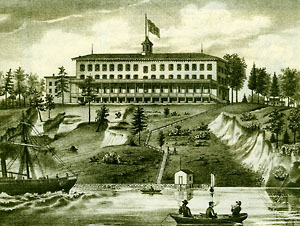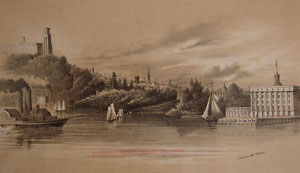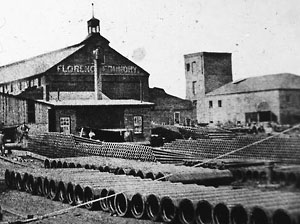
“Trall’s Hygeian Home and Hygeo Therapeutic College”. R.T. Trall was a leading advocate of “water cures” and healthy lifestyle regimen in the nineteenth century. He opened a treatment facility and training center for doctors in Florence in 1867. Credit: J.D. Scott, Combination Atlas Map of Burlington County New Jersey, 1876. Special Collections and University Archives, Rutgers University Libraries
Located along the Delaware River on the northern boundary of Burlington County, Florence Township is one of the county’s smallest townships, with an area of 9.65 square miles. Created in 1872, the township was originally part of Mansfield Township. Florence is also the name of the original settlement. Roebling, a former company town established in 1904, is adjacent to Florence.
The first permanent European settlers here were English farmers who arrived in the 1770s. For a brief period in the nineteenth century, Florence was a resort, popular recreation spot, and center for “water cures’ and natural healing. Industrial development did not occur until steamboats and the new Camden and Amboy railroad made the area more accessible. With the development of rail and water transportation, iron and later steel production became a mainstay of the local economy. The environmental consequences of heavy industry are still visible.

Artist’s conception of Florence City when developed. Mid-nineteenth century. Credit: Special Collections and University Archives, Rutgers University Libraries
The site of Florence city was originally known as High Banks. It now is known as Florence-Roebling. In the nineteenth century the attractive riverside setting, which was just a short boat trip from Philadelphia, became a popular recreation spot. In 1849, New York real estate entrepreneurs decided the area had the potential to attract homeowners. They purchased 600 acres and formed the Florence City Company. The developers set out to create a planned residential community. To attract buyers, they built a wharf, hotel, large boarding house, landscaped streets and brick houses. The business venture was initially successful, and for a brief period the village became a popular summer resort. The Florence City Company experienced financial difficulties and was sold in 1854. In the late 1860s, R.T. Trall, a prolific author, lecturer, social reformer and advocate of water cures established a hydrotherapy treatment and medical training facility in Florence Heights. Trall’s hygienic regimen and recommendations for “natural healing’ may sound familiar to us: fresh air, wholesome diet, regular exercise, adequate rest, abstinence from stimulants and drugs of all kinds, rational dress and attention to one’s mental health.

Circa 1890 photograph of original pipe foundry at Florence N.J. Credit: Hagley Museum and Library
An economic revival and a new chapter in the town’s history began in 1857-58 when Richard Jones established the Florence Iron Works, the town’s first industry. After the company was sold a decade later to R.D. Wood & Company the ironworks expanded substantially. The company fabricated water and gas pipes, fire hydrants, valves, and other cast iron products that were marketed in the U.S. and Europe. Foundry owners built simple housing, recreational facilities, a library, and other amenities for their workers, and more housing and businesses were added when new foundries were built in the twentieth century. The R. D. Wood Company was sold to Griffin Pipe Foundry. That company is now part of a larger manufacturing corporation, Amsted Industries. The Florence plant produced ductile iron pressure pipe used by the construction industry until 2009.
In 1904, the renowned Roebling Company of Trenton, a world-famous bridge design and construction firm decided to expand manufacturing capacity. They chose a site near the Kinkora railway station in Florence Township for a new steel mill, wire fabrication plant, and a self-contained company town for the immigrant workers they hired. Their new plant, known as the Kinkora Works, and the town of Roebling were the largest capital investment in the company’s history. The Roebling plant ceased operations in the 1980s.
Florence is the site of a notorious waste disposal facility that also became one of the nation’s “Superfund’ environmental clean-up projects. Florence Land Recontouring (FLR) Landfill operated a licensed 60-acre municipal disposal facility for sanitary and non-chemical wastes. The site borders Assiscunk Creek, a tributary of the Delaware River, and extended into adjacent Mansfield and Springfield Townships. In 1975, shortly after the landfill opened, the state discovered that hazardous chemical wastes had been dumped there illegally. As a result, groundwater and soils were contaminated with volatile organic compounds. In 1979, the courts ordered the landfill closed to protect groundwater supplies and public health. The hazardous site included 29 acres, two lagoons, a pond, and tanks. The landfill was capped and containment systems were constructed. In 1984, the Federal Environmental Protection Agency added the site to its National Priorities List of Superfund sites. Work began to prevent further leakage, remove and treat toxic materials, protect groundwater supplies and monitor pollution. By 2004, remediation measures proved successful, and the site no longer posed a significant threat to public health or the environment. After more than 20 years of environmental remediation, the FLR was removed from the federal list of superfund sites. Access is restricted and the site remains vacant.
For more information:
Banner credit: Special Collections and University Archives, Rutgers University Libraries






